
The archbishop of Canterbury is the senior bishop and a principal leader of the Church of England, the ceremonial head of the worldwide Anglican Communion and the bishop of the Diocese of Canterbury. The current archbishop is Justin Welby, who was enthroned at Canterbury Cathedral on 21 March 2013. Welby is the 105th person to hold the position, as part of a line of succession going back to the "Apostle to the English" Augustine of Canterbury, who was sent to the island by the church in Rome in 597. Welby succeeded Rowan Williams.

Thomas Wolsey was an English statesman and Catholic bishop. When Henry VIII became King of England in 1509, Wolsey became the king's almoner. Wolsey's affairs prospered and by 1514 he had become the controlling figure in virtually all matters of state. He also held important ecclesiastical appointments. These included the Archbishop of York—the second most important role in the English church—and that of papal legate. His appointment as a cardinal by Pope Leo X in 1515 gave him precedence over all other English clergy.
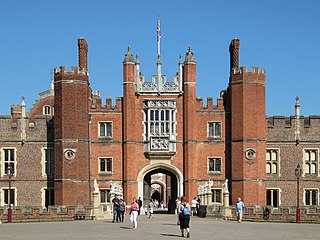
Hampton Court Palace is a Grade I listed royal palace in the London Borough of Richmond upon Thames, 12 miles southwest and upstream of central London on the River Thames.

Canterbury Cathedral in Canterbury, Kent, is one of the oldest and most famous Christian structures in England. It forms part of a World Heritage Site. It is the cathedral of the Archbishop of Canterbury, currently Justin Welby, leader of the Church of England and symbolic leader of the worldwide Anglican Communion. Its formal title is the Cathedral and Metropolitical Church of Christ at Canterbury.

The Palace of Placentia, also known as Greenwich Palace, was an English royal residence that was initially built by Humphrey, Duke of Gloucester, in 1443. The palace was a place designed for pleasure, entertainment and an escape from the city. It was located at Greenwich on the south bank of the River Thames, downstream from London. On a hill behind the palace he built Duke Humphrey's Tower, later known as Greenwich Castle; it was subsequently demolished to make way for the Royal Observatory, Greenwich, which survives. The original river-side residence was extensively rebuilt around 1500 by Henry VII. A detached residence, the Queen's House, was built on the estate in the early 1600s and also survives. In 1660, the main palace was demolished by Charles II to make way for a proposed new palace, which was never constructed. Nearly forty years later, the Greenwich Hospital was built on the site.
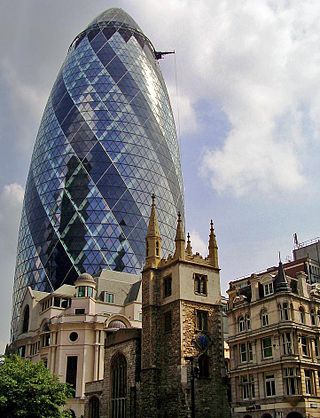
The architecture of England is the architecture of modern England and in the historic Kingdom of England. It often includes buildings created under English influence or by English architects in other parts of the world, particularly in the English and later British colonies and Empire, which developed into the Commonwealth of Nations.

A fan vault is a form of vault used in the Gothic style, in which the ribs are all of the same curve and spaced equidistantly, in a manner resembling a fan. The initiation and propagation of this design element is strongly associated with England.
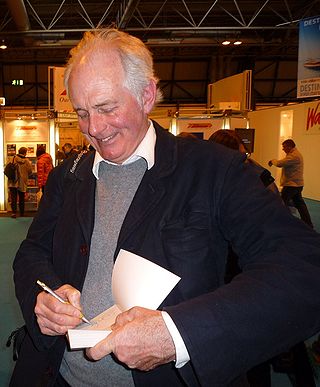
Daniel Gordon Raffan Cruickshank is a British art historian and BBC television presenter, with a special interest in the history of architecture.

Son et lumière, or a sound and light show, is a form of nighttime entertainment that is usually presented in an outdoor venue of historic significance.

The Tudor architectural style is the final development of medieval architecture in England and Wales, during the Tudor period (1485–1603) and even beyond, and also the tentative introduction of Renaissance architecture to Britain. It followed the Late Gothic Perpendicular style and, gradually, it evolved into an aesthetic more consistent with trends already in motion on the continent, evidenced by other nations already having the Northern Renaissance underway Italy, and especially France already well into its revolution in art, architecture, and thought. A subtype of Tudor architecture is Elizabethan architecture, from about 1560 to 1600, which has continuity with the subsequent Jacobean architecture in the early Stuart period.
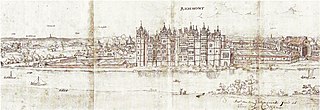
Richmond Palace was a royal residence on the River Thames in England which stood in the sixteenth and seventeenth centuries. Situated in what was then rural Surrey, it lay upstream and on the opposite bank from the Palace of Westminster, which was located nine miles (14 km) to the north-east. It was erected in about 1501 by Henry VII of England, formerly known as the Earl of Richmond, in honour of which the manor of Sheen had recently been renamed "Richmond". Richmond Palace therefore replaced Shene Palace, the latter palace being itself built on the site of an earlier manor house which had been appropriated by Edward I in 1299 and which was subsequently used by his next three direct descendants before it fell into disrepair.

London's architectural heritage involves many architectural styles from different historical periods. London's architectural eclecticism stems from its long history, continual redevelopment, destruction by the Great Fire of London and The Blitz, and state recognition of private property rights which have limited large-scale state planning. This sets London apart from other European capitals such as Paris and Rome which are more architecturally homogeneous. London's architecture ranges from the Romanesque central keep of The Tower of London, the great Gothic church of Westminster Abbey, the Palladian royal residence Queen's House, Christopher Wren's Baroque masterpiece St Paul's Cathedral, the High Victorian Gothic of The Palace of Westminster, the industrial Art Deco of Battersea Power Station, the post-war Modernism of The Barbican Estate and the Postmodern skyscraper 30 St Mary Axe 'The Gherkin'.

Otford Palace, also known as the Archbishop's Palace, is in Otford, an English village and civil parish in the Sevenoaks District of Kent. The village is located on the River Darent, flowing north down its valley from its source on the North Downs.

The medieval cathedrals of England, which date from between approximately 1040 and 1540, are a group of twenty-six buildings that constitute a major aspect of the country's artistic heritage and are among the most significant material symbols of Christianity. Though diverse in style, they are united by a common function. As cathedrals, each of these buildings serves as central church for an administrative region and houses the throne of a bishop. Each cathedral also serves as a regional centre and a focus of regional pride and affection.
Simon John Thurley, is an English academic and architectural historian. He served as Chief Executive of English Heritage from April 2002 to May 2015. In April 2021, he became Chair of the National Lottery Heritage Fund.

Suzannah Rebecca Gabriella Lipscomb is a British historian and professor emerita at the University of Roehampton, a Fellow of the Royal Historical Society, the Higher Education Academy and the Society of Antiquaries, and has for many years contributed a regular column to History Today. She has written and edited a number of books, presented numerous historical documentaries on TV and is host of the Not Just the Tudors podcast from History Hit. She is also a royal historian for NBC.
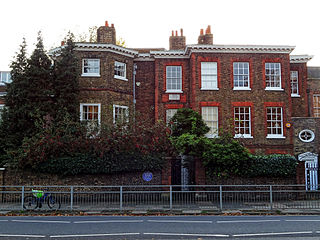
The Old Court House is a Grade II* listed house located off Hampton Court Green in the London Borough of Richmond upon Thames; its origins date back to 1536. The architect Sir Christopher Wren, who lived there from 1708 to 1723, was given a 50-year lease on the property by Queen Anne in lieu of overdue payments for his work on St Paul's Cathedral. The lease passed from Wren's son to his grandson. It was purchased from the Crown Estate in 1984.
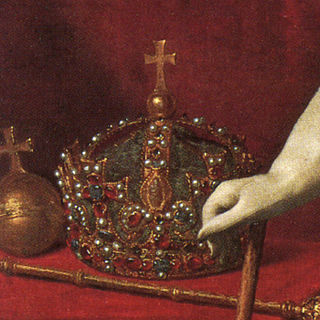
The Tudor Crown, also known as Henry VIII's Crown, was the imperial and state crown of English monarchs from around the time of Henry VIII until it was destroyed during the Civil War in 1649. It was described by the art historian Sir Roy Strong as "a masterpiece of early Tudor jeweller's art", and its form has been compared to the crown of the Holy Roman Empire.
Donald Insall Associates is a firm of architects, designers and historic building consultants in the United Kingdom.
The Story of Abraham is a set of ten Brussels tapestries depicting stories from the life of the biblical prophet Abraham. They appear to have been designed by Bernaert van Orley initially, but completed by Pieter Coecke van Aelst around 1537, both artists who were leading designers for the Brussels workshops. Three sets survive.

















